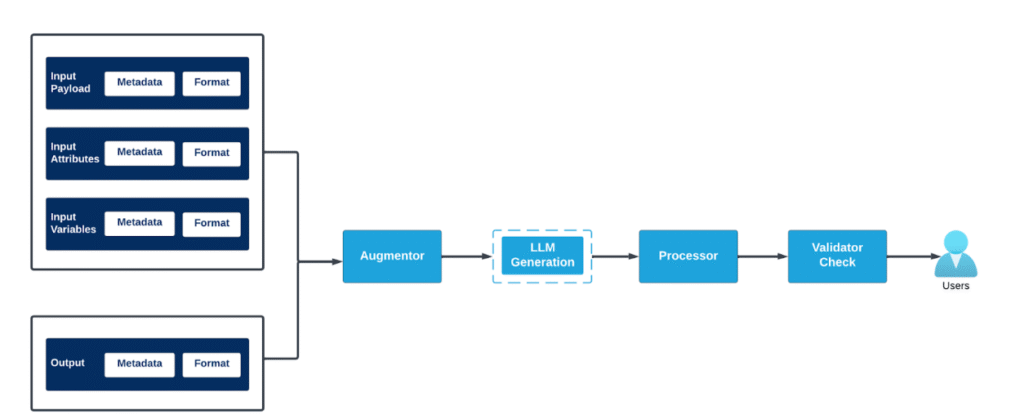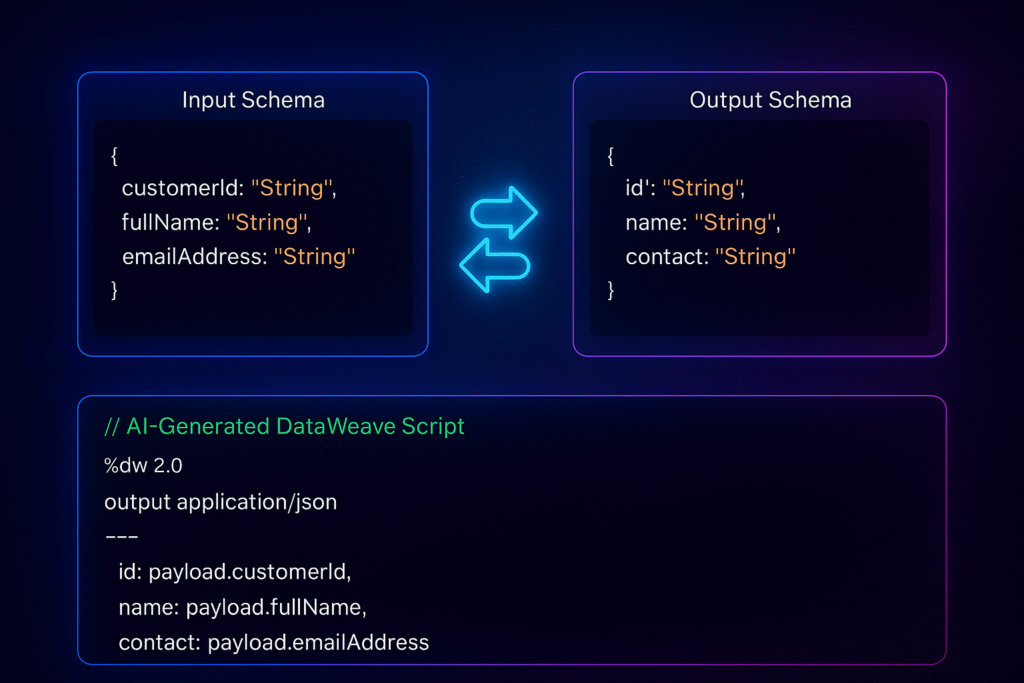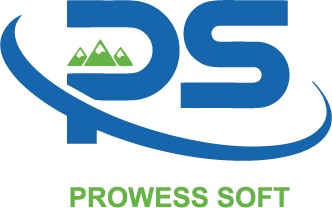Blog
Data Transformation Using AI in MuleSoft
- October 28, 2025
- Harshitha Konakanchi
Introduction: The Future of Data Transformation in MuleSoft
Developers often spend hours writing DataWeave scripts for complex data transformations—testing, debugging, and revising them manually. These repetitive tasks slow delivery and introduce avoidable errors.
What if AI could generate most of the script automatically?
That’s exactly what MuleSoft is making possible. MuleSoft, a leading data integration and automation platform, connects applications, systems, and data across cloud and on-premises environments. Using DataWeave, MuleSoft enables robust data transformation across diverse formats and systems.
However, while DataWeave is powerful, it’s also time-intensive to write manually. With AI-powered DataWeave script generation, MuleSoft’s AI-driven transformation features now automate much of this effort, helping developers accelerate script generation and reduce errors.
AI-Powered Data Transformation in MuleSoft
MuleSoft’s AI enhancements focus on two intelligent script generation techniques:
- Automated Field Mapping (Metadata-based AI Generation)
- Sample Data-Driven Transformation (Example-based AI Learning)
Both approaches rely on large language models (LLMs) and context-aware data analysis to produce accurate and consistent DataWeave scripts with minimal human input.
Intelligent script generation for automated field mapping

The pipeline begins by collecting metadata and format details from the input payload, attributes, and variables, along with the definition of the expected output. This information forms the foundation for the AI to understand how the transformation should look.
From there, the data moves into the Augmenter, which enriches the request and prepares it for script creation. The LLM generator then takes over, drafting an initial DataWeave script that reflects the provided mappings.
Once the draft is ready, it flows into the Processor, where the script is polished, structured, and made more consistent. Finally, a Validator check runs through the generated output to catch errors or mismatches. At this stage, the script is handed off to developers, who only need to refine the few unmapped or complex fields that the AI leaves blank.
Input and output with AI-generated DataWeave script from metadata

Intelligent script generation for sample data-driven transformation

In this approach, instead of schemas or metadata, the AI is provided with example input and output pairs. From these, it learns the rules and patterns needed to produce accurate DataWeave scripts.
Here’s how the pipeline works:
- Intention Reasoning – Interprets the prompt and examines the sample data to understand the intended transformation.
- Retrieval & Augmentation – Collects additional context and enriches the request so the AI has enough information to generate meaningful mappings.
- LLM Generation – Produces a first draft of the DataWeave script based on the patterns it identifies.
- Post-Processor – Cleans up the script, improves formatting, and ensures consistency across transformations.
- Validator & Safety Check – Tests the script against expected output to confirm accuracy and functional safety.
- Error Correction Module – Automatically identifies and fixes remaining issues before presenting the final script.
This sample-driven method often results in more accurate and context-aware transformations, since the AI can directly learn from real data examples rather than relying only on metadata.
Input and output with AI-generated DataWeave script from sample data

Comparison between AI and traditional DataWeave
Criteria | Traditional DataWeave | AI-Generated DataWeave |
Time to Develop | Hours to days | Minutes |
Error Rate | Higher (manual mistakes, debugging) | Lower (AI validation & correction) |
Complex Logic | Manual coding needed | Learns from examples |
Scalability | Slow, human-limited | Faster, AI-assisted |
Developer Effort | High | Reduced |
Use Cases | Complex, edge-case scenarios | Standard mappings, repetitive work |
Real Life Example
When migrating to mulesoft customer records from a legacy CRM into Salesforce, developers often spend hours writing transformation scripts.
Traditional Way: A developer manually maps customer IDs, splits full names into first and last names, normalizes email formats, and ensures phone numbers follow Salesforce standards.
With AI-Generated DataWeave: By providing a few sample records, the AI generates a draft script that performs 80–90% of these transformations automatically. The developer only adjusts complex edge cases, reducing the effort from days to just a few hours.
This approach speeds up delivery while ensuring accuracy and consistency across thousands of records.
Benefits of AI-Driven Data Transformation
- 80% Faster Development – Reduced manual scripting time.
- Fewer Errors – Built-in validation ensures accuracy.
- Higher Productivity – Developers focus on innovation, not routine mapping.
- Better Scalability – Handles large, repetitive transformations with ease.
- Consistency & Compliance – Automated validation prevents format mismatches.
Business Impact: From Hours to Minutes
Organizations adopting AI in MuleSoft see:
- 30–40% faster integration delivery
- Up to 50% reduction in transformation costs
- Greater agility for digital transformation projects
- Improved developer satisfaction and reduced burnout
Conclusion: The Future of DataWeave is AI-Driven
AI is fundamentally changing how developers approach data transformation in MuleSoft. What once took hours of manual coding and debugging can now be achieved in minutes through AI-assisted script generation.
As MuleSoft continues integrating AI capabilities, DataWeave scripting will evolve into a human–AI collaboration, where developers define the intent, and the AI executes it.
The outcome?
- Faster project delivery
- Consistent, accurate transformations
- Reduced operational costs
- Accelerated innovation

Editor: Harshitha Konakanchi
Frequently Asked Questions:
AI-driven data transformation uses machine learning and LLMs to automatically generate DataWeave scripts for faster and more accurate data mapping.
AI assists in field mapping and transformation by analyzing metadata or sample data to auto-generate scripts.
No, AI accelerates development, but developers still fine-tune complex mappings and business logic.
Reduced errors, faster delivery, higher productivity, and better data consistency
Yes, recent MuleSoft updates embedded AI for automated field mapping and sample-based transformations.
Metadata-driven uses schemas; sample-driven learns from example input/output pairs.
Typically covers 80–90% of transformation logic accurately, requiring minimal manual edits.
Yes, AI-generated DataWeave simplifies migration from legacy systems to modern platforms like Salesforce or SAP.
By auto-generating boilerplate mapping scripts and validating them instantly.
Yes, MuleSoft ensures data security through validation layers and safe LLM generation pipelines.
